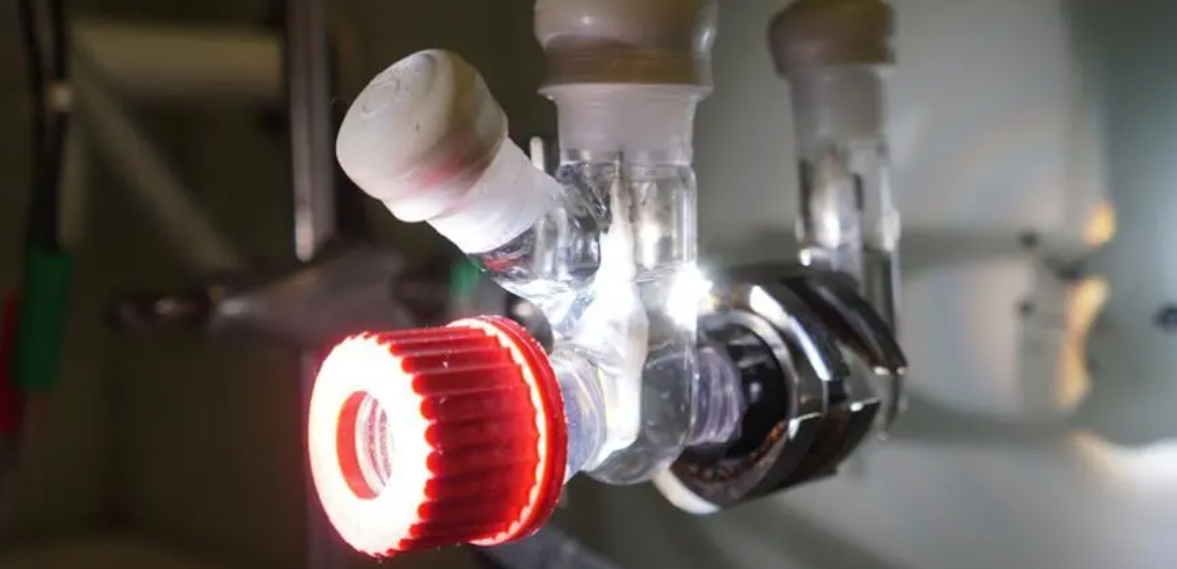Solar-powered system converts plastic and greenhouse gases into sustainable fuels
剑桥研究人员开发了一种可将塑料废物和温室气体转化为可持续燃料和其他有价值产品的系统,该系统仅使用太阳能。
Researchers have developed a system that can transform plastic waste and greenhouse gases into sustainable fuels and other valuable products – using just the energy from the Sun.

将塑料和温室气体转化为可持续燃料的太阳能反应器
Solar-powered reactor for converting plastic
and greenhouse gases into sustainable fuels
Credit: Reisner Lab 图源:Reisner实验室
剑桥大学的研究人员开发了该系统,其可同时将两种废物流转化为两种化学产品——这在太阳能反应器中尚属首次。
The researchers, from the University of Cambridge, developed the system, which can convert two waste streams into two chemical products at the same time – the first time this has been achieved in a solar-powered reactor.
该反应器将二氧化碳和塑料转化为可用于各行各业的不同产品。在测试中,二氧化碳被转化为合成气,这是可持续液体燃料的关键组成部分,塑料瓶被转化为乙醇酸,广泛用于化妆品行业。通过改变反应器中使用的催化剂类型,可以轻松调整该系统以生产不同产品。
The reactor converts carbon dioxide (CO2) and plastics into different products that are useful in a range of industries. In tests, CO2 was converted into syngas, a key building block for sustainable liquid fuels, and plastic bottles were converted into glycolic acid, which is widely used in the cosmetics industry. The system can easily be tuned to produce different products by changing the type of catalyst used in the reactor.
利用太阳能将塑料和温室气体——自然界面临的两大威胁——转化为有用和有价值的产品,是向更可持续的循环经济过渡的重要一步。该项结果发表在《自然•合成》杂志上。
Converting plastics and greenhouse gases – two of the biggest threats facing the natural world – into useful and valuable products using solar energy is an important step in the transition to a more sustainable, circular economy. The results are reported in the journal Nature Synthesis.
“利用太阳能将废物转化为有用产物是我们研究的主要目标,”该论文的资深作者、来自 Yusuf Hamied化学系的Erwin Reisner教授说。“塑料污染是世界范围内的一个大问题,通常我们扔进回收箱的许多塑料都会被焚烧或最终进入垃圾填埋场。”
“Converting waste into something useful using solar energy is a major goal of our research,” said Professor Erwin Reisner from the Yusuf Hamied Department of Chemistry, the paper’s senior author. “Plastic pollution is a huge problem worldwide, and often, many of the plastics we throw into recycling bins are incinerated or end up in landfill.”
Reisner还领导剑桥循环塑料中心 (CirPlas),该中心旨在通过将奇思妙想与实际措施相结合来消除塑料垃圾。
Reisner also leads the Cambridge Circular Plastics Centre (CirPlas), which aims to eliminate plastic waste by combining blue-sky thinking with practical measures.
其他太阳能“回收”技术有望解决塑料污染和减少大气中的温室气体含量,但迄今为止,它们还没有整合在一个单一的过程中。
Other solar-powered ‘recycling’ technologies hold promise for addressing plastic pollution and for reducing the amount of greenhouse gases in the atmosphere, but to date, they have not been combined in a single process.
该论文的共同第一作者 Subhajit Bhattacharjee 说:“一项可以同时解决塑料污染和温室气体问题的太阳能驱动技术可能会改变循环经济发展的游戏规则。”
“A solar-driven technology that could help to address plastic pollution and greenhouse gases at the same time could be a game-changer in the development of a circular economy,” said Subhajit Bhattacharjee, the paper’s co-first author.
“我们还需要一些可以调整的东西,这样你就可以根据想要的最终产品轻松地做出改变,”共同第一作者Motiar Rahaman博士说。
“We also need something that’s tuneable, so that you can easily make changes depending on the final product you want,” said co-first author Dr Motiar Rahaman.
研究人员开发了一种具有两个独立隔间的集成反应器:一个用于塑料,一个用于温室气体。该反应器使用基于钙钛矿的光吸收器——一种可能应用在下一代太阳能电池上的硅替代品。
The researchers developed an integrated reactor with two separate compartments: one for plastic, and one for greenhouse gases. The reactor uses a light absorber based on perovskite – a promising alternative to silicon for next-generation solar cells.
该团队设计了不同的催化剂,并将其集成到光吸收器中。通过改变催化剂,研究人员可以改变最终产品。在常温常压条件下对该反应器进行的测试表明,除乙醇酸外,该反应器还可以有效地将PET塑料瓶和二氧化碳转化为一氧化碳、合成气或甲酸盐等不同的碳基燃料。剑桥开发的反应器生产这些产品的速度也远高于传统的光催化二氧化碳还原过程。
The team designed different catalysts, which were integrated into the light absorber. By changing the catalyst, the researchers could then change the end product. Tests of the reactor under normal temperature and pressure conditions showed that the reactor could efficiently convert PET plastic bottles and CO2 into different carbon-based fuels such as CO, syngas or formate, in addition to glycolic acid. The Cambridge-developed reactor produced these products at a rate that is also much higher than conventional photocatalytic CO2 reduction processes.
“一般来说,二氧化碳转化需要大量能量,但使用我们的系统,基本上你只需照亮它,它就会开始将有害产物转化为有价值和可持续的产品,”Rahaman 说。“在这个系统之前,我们无法如此高效地制造高价值产品。”
“Generally, CO2 conversion requires a lot of energy, but with our system, basically you just shine a light at it, and it starts converting harmful products into something useful and sustainable,” said Rahaman. “Prior to this system, we didn’t have anything that could make high-value products selectively and efficiently.”
“这个系统的特别之处在于它的多功能性和可调性——我们现在正在制造相当简单的碳基分子,但在未来,我们可以通过改变催化剂来调整系统,制造更复杂的产品”,Bhattacharjee说。
“What’s so special about this system is the versatility and tuneability – we’re making fairly simple carbon-based molecules right now, but in future, we could be able to tune the system to make far more complex products, just by changing the catalyst,” said Bhattacharjee.
Reisner最近获得了欧洲研究委员会的新资助,来帮助开发太阳能反应器。在接下来的五年里,他们希望进一步开发反应器来生产更复杂的分子。研究人员说,有朝一日可以使用类似的技术来开发完全由太阳能供电的回收厂。
Reisner recently received new funding from the European Research Council to help the development of their solar-powered reactor. Over the next five years, they hope to further develop the reactor to produce more complex molecules. The researchers say that similar techniques could someday be used to develop an entirely solar-powered recycling plant.
Reisner说:“如果我们要切实解决气候危机并保护自然世界,发展循环经济至关重要,我们可以利用废物制造有用的产品,而不是将其扔进垃圾填埋场。使用太阳能为这些解决方案提供动力意味着我们正在以清洁和可持续的方式进行。”
“Developing a circular economy, where we make useful things from waste instead of throwing it into landfill, is vital if we’re going to meaningfully address the climate crisis and protect the natural world,” said Reisner. “And powering these solutions using the Sun means that we’re doing it cleanly and sustainably.”
该研究得到了欧盟、欧洲研究委员会、剑桥信托基金、Hermann和Marianne Straniak 基金会以及英国研究与创新署 (UKRI) 下属的工程与物理科学研究委员会 (EPSRC) 的支持。Erwin Reisner来自剑桥大学圣约翰学院。
The research was supported in part by the European Union, the European Research Council, the Cambridge Trust, Hermann and Marianne Straniak Stiftung, and the Engineering and Physical Sciences Research Council (EPSRC), part of UK Research and Innovation (UKRI). Erwin Reisner is a Fellow of St John’s College, Cambridge.

 中文
中文 English
English
